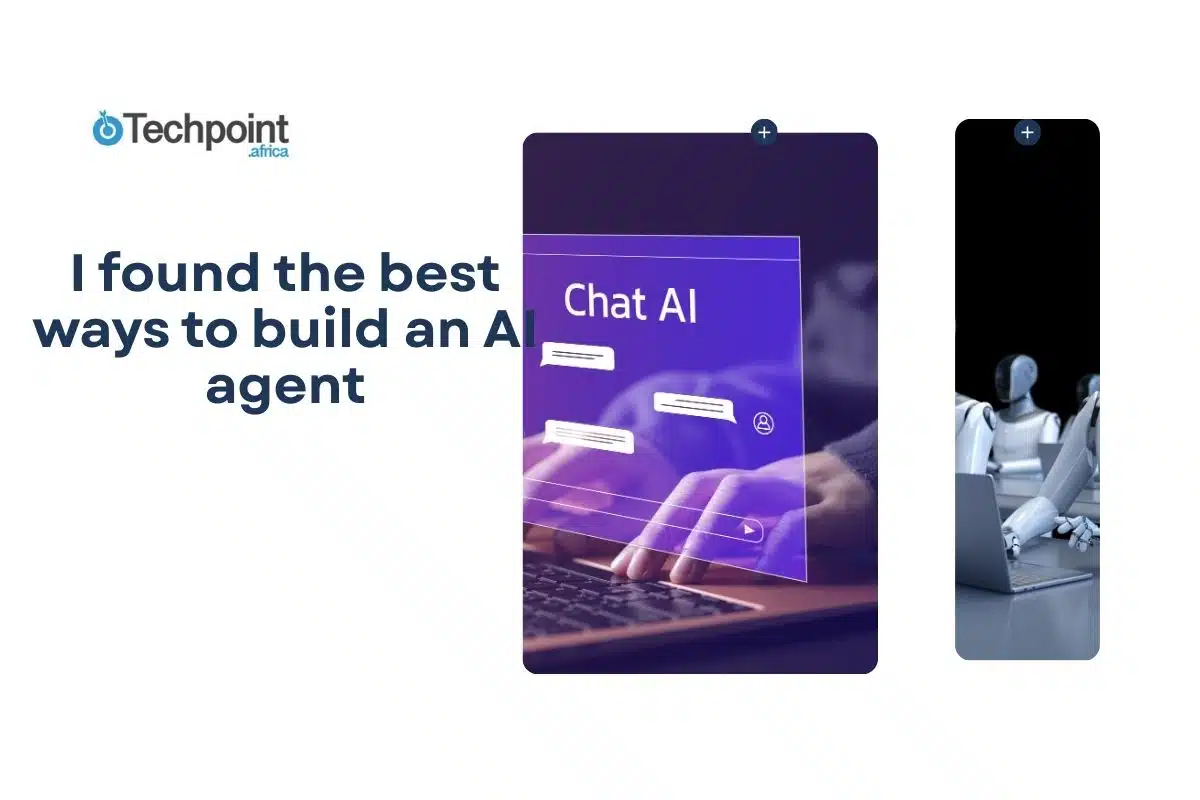
Everyone’s talking about AI agents, but when it’s time to actually build one, the steps aren’t always clear. Should you write it from scratch? Use a prebuilt framework? Fine-tune a language model?
I wanted answers. So I explored different ways to build AI agents including simple ones, complex ones, and everything in between. Some approaches were fast. Others gave more control. A few looked promising but didn’t quite deliver.
This article breaks down what I found. You’ll see what works best for different goals, which tools are worth your time, and how to avoid getting stuck. Whether you’re building a chatbot, an automation tool, or something more advanced, there’s a better way to do it, and I’ll show you how.
What is an AI agent, really?
An AI agent is a system that can observe, decide, and act based on a defined goal. Unlike regular programs that only follow a fixed set of instructions, AI agents are designed to respond dynamically to their environment. They can adapt, learn, or plan depending on how they’re built.
At a technical level, an AI agent follows a cycle: Input (perception) → Processing (decision-making) → Output (action).
There are different types of AI agents:
- Rule-based agents follow predefined logic.
- Model-based agents keep track of internal states or history.
- Goal-based agents evaluate future outcomes before choosing actions.
- Learning agents improve their behavior over time using data or experience.
These concepts guide how you build and deploy agents in real-world applications. Whether you’re creating a virtual assistant, a customer service bot, or a research automation tool, your agent will fall into one or more of these categories.
Understanding this foundation helps you choose the right architecture, tools, and development path. It also ensures you’re building with purpose, not just assembling code that runs.
What makes an AI agent “good”?
Before jumping into how to build an AI agent, it’s important to define what we’re aiming for. Not every agent is useful. And not every “smart” system is truly intelligent.
An AI agent isn’t just a model that spits out answers. It’s a system that can take input, make decisions, and act, ideally with a degree of autonomy, clarity, and reliability.
Whether you’re building something as simple as a rule-based chatbot or as complex as a reasoning assistant that uses external tools, here are the criteria that separate an average agent from a solid one.
- A clear, well-scoped objective
A good AI agent solves a specific problem, not ten problems at once. Vague agents that try to “handle everything” end up doing nothing well. The most effective systems are tightly focused.
For example:
- A rule-based agent might handle shipping inquiries on an e-commerce site.
- An ML-based agent might classify support tickets into categories.
- An LLM agent might summarize research papers and highlight key findings.
Before you even think about code, you should be able to write a one-sentence answer to: “What will this agent do, and for whom?”
That clarity shapes your architecture, tools, and expectations.
- Reliable input understanding
An agent can’t act correctly if it misinterprets input. This is where many beginner projects fall apart, especially those relying on raw language input. A good AI agent either:
- Limits input to structured formats (buttons, form fields, predefined commands), or
- Handles unstructured input gracefully using language models or NLP pipelines.
In other words, your agent should have a consistent strategy for interpreting what the user wants, whether through strict rules or semantic understanding.
- Decision-making that fits the task
Every agent needs some way to choose what to do next. The decision-making engine might be:
- A logic tree
- A classifier
- A planning algorithm
- A generative model reasoning through a multi-step prompt
The best agents don’t just respond, they choose responses based on logic, goals, or context. This is what separates “bots” from agents.
- Feedback Awareness (Optional, but Powerful)
Not all agents need feedback loops, but the great ones can evaluate or improve their own actions. This could be as simple as:
- Logging when a response fails
- Asking, “Was this helpful?”
- Adapting based on reward signals or past interactions
Agents that learn or adapt over time (like reinforcement learning agents or memory-equipped LLM agents) offer more long-term value, especially in complex environments.
- Tool Use or Environment Interaction
Autonomy increases when agents can interact with systems beyond themselves. This might look like:
- Fetching data from a weather API
- Reading a document
- Sending an email
- Navigating a simulated environment
- Triggering a webhook
Agents that only generate text are still useful, but the ability to act in the world is what unlocks real automation.
- Stability, Observability, and Control
This is often ignored until it’s too late.
A good AI agent:
- Doesn’t crash when input changes slightly
- Can be observed (via logs, traces, or step-by-step output)
- Can be paused, adjusted, or retrained if needed
- Doesn’t become a black box that surprises its own builder
This is especially important if you’re building something for users or clients.
- Reasonable to Build and Maintain
If it takes three months and five engineers to get a working prototype, that’s not practical for most builders.
A good agent:
- Can be shipped in stages
- Starts simple and improves over time
- Doesn’t lock you into obscure tools
- Has clear trade-offs: speed vs flexibility, cost vs capability
Choosing the right approach upfront (rule-based, ML, or LLM) saves you from redoing your entire architecture later.
A good AI agent is clear in purpose, consistent in action, and stable in use. It doesn’t need to be flashy or deeply intelligent; it just needs to solve one real problem reliably.

What kind of AI agent should you build? (and why it matters)
Before choosing any tools or writing code, you need to define what your AI agent is meant to do. The type of agent you build should align with the complexity of the task, the environment it operates in, and how much adaptability you need.
Here are the main categories to consider:
- Reactive (Simple Reflex) Agents
These are the most basic type of agents. They operate on a strict stimulus-response model, meaning they respond to specific inputs with fixed outputs. There’s no memory, no context, and no ability to adapt over time.
How they work: “If condition X is detected, do action Y.” That’s it.
Example: A rule-based chatbot that responds to specific keywords (e.g., “hours,” “location,” or “pricing”) with canned replies.
Use when:
- The environment is fully observable and predictable.
- You need something lightweight and fast.
- Logic doesn’t change often.
Limitations:
- Cannot handle ambiguity or nuance.
- Breaks easily in dynamic or complex environments.
- No learning or improvement over time.
2. Model-Based Agents
Model-based agents build a representation of their environment. This allows them to make better decisions by keeping track of what has happened and predicting what might happen next. They’re more flexible than reactive agents but still follow predefined rules.
How they work: They use a world model (state tracker) to infer unobservable information, then act based on both current and stored data.
Example: A thermostat that adjusts heating based on current temperature and trends over time, not just immediate input.
Use when:
- The environment has hidden or partial information.
- The agent needs to track history or context.
- You need more stability than a reactive system provides.
Limitations:
- Still rule-based, no true learning.
- Complexity grows with the state model.
3. Goal-Based Agents
These agents go beyond reacting. They’re designed to evaluate possible future states and make decisions that help them achieve specific goals. They often use search and planning algorithms to choose optimal actions.
How they work: They calculate different action paths and select the one most likely to reach the desired outcome.
Example: A route-finding app like Google Maps — it doesn’t just react to your current location but searches all paths to find the best one to your destination.
Use when:
- The task involves planning or optimization.
- You need goal-driven reasoning (not just reaction).
- Multiple possible outcomes exist for each action.
Limitations:
- Computationally expensive.
- Doesn’t inherently adapt unless combined with learning.
4. Learning Agents
Learning agents take adaptability to the next level. These systems use data and feedback to improve performance over time. Some use supervised learning (training on labeled data), while others use reinforcement learning, learning through trial and error.
How they work: They analyze performance, adjust behavior, and learn new strategies based on outcomes or feedback from the environment.
Example: A recommendation engine that gets better with every user interaction, like Netflix suggesting new shows based on what you’ve watched.
Use when:
- Your task involves complex patterns or unpredictable inputs.
- There’s enough data for the system to learn from.
- You want long-term performance improvements.
Limitations:
- Requires time and resources for training and tuning.
- Performance isn’t guaranteed early on.
- Needs constant monitoring and updates.
5. LLM-Based Agents (Language Model-Driven)
LLM-based agents are a newer, powerful category made possible by large language models like GPT-4. These agents are capable of reasoning in natural language, using external tools, maintaining memory, and following multi-step instructions.
They often use frameworks like LangChain, AutoGen, or OpenAI’s Assistants API to wrap reasoning, tools, and memory into a cohesive agent.
How they work: They interpret prompts or instructions, decide what tools to use or questions to ask, then output a result that sounds human and relevant. Many can also chain actions (known as task planning).
Example: A research assistant agent that reads websites, summarizes findings, answers questions, and saves relevant notes to memory, all in one session.
Use when:
- You need language understanding and multi-step task execution.
- You’re building a conversational agent, workflow tool, or autonomous task bot.
- You want quick results with high-level capabilities.
Limitations:
- Expensive to run at scale.
- Output can be unpredictable if not tightly scoped.
- May require tool integrations or custom prompts to perform reliably.
The architecture you choose affects every other decision, from tools and frameworks to deployment.
Here’s a quick reference:
| If your task involves… | Choose this agent type |
| Direct responses to fixed input | Reactive agent |
| Context awareness or state tracking | Model-based agent |
| Planning toward specific outcomes | Goal-based agent |
| Learning from feedback or data | Learning agent (ML/RL) |
| Language-based reasoning or multi-step tasks | LLM-based agent |
The best ways to build an AI agent (based on task, tools, and power)
When it comes to building an AI agent, there’s no single best method. The right approach depends on what your agent needs to do, how much control you want, and what resources you have including time, data, or compute.
After testing and comparing several approaches, I’ve narrowed it down to the three most effective methods. Each one solves different types of problems, and each comes with its own learning curve, strengths, and limitations.
We’ll break down how to build each one step-by-step, the tools you’ll need, and where each method works.
How to build a rule-based AI agent (best for simple, structured tasks)
Rule-based agents are the simplest form of intelligent systems. They don’t learn or adapt, they follow clear, hardcoded instructions. But for many tasks, that’s not a weakness. It’s a strength.
If your agent’s job is to respond to a fixed set of inputs with consistent, accurate outputs, rule-based logic is your best bet.
Let’s walk through how to build one from scratch, step-by-step.
What You’ll Need
- Python (you can also use JavaScript, but we’ll use Python for this walkthrough)
- Basic understanding of conditionals and functions
- Optional: Regular expressions for input matching
- Optional: Flask, Streamlit, or CLI if you want to deploy it with an interface
Step 1: Define the Problem Clearly
Start with a narrow, specific task.
Let’s say we’re building a simple support agent for a local delivery business. It should answer basic customer questions like:
- “What time do you open?”
- “How much is delivery?”
- “Can I return my item?”
You don’t need hundreds of cases. Start with 5–10 questions you want the agent to handle.
Step 2: Map Input Triggers to Responses
Now, you define a dictionary of known phrases → linked to appropriate replies.
responses = {
“what are your hours”: “We’re open from 9 AM to 5 PM, Monday to Saturday.”,
“how much is delivery”: “Delivery costs a flat rate of $5.”,
“can i return my item”: “Yes, returns are accepted within 7 days with a receipt.”
}
Keep your keys lowercase and simple. Later, you can make it more flexible with keyword matching or regex.
Step 3: Build the Matching Engine
Now, create a function that takes user input, scans for matching phrases, and returns the response.
def rule_based_agent(user_input):
user_input = user_input.lower()
for key in responses:
if key in user_input:
return responses[key]
return “Sorry, I didn’t understand that. Can you rephrase?”
Right now, this uses simple substring matching. It’s not sophisticated, but it works well for controlled input.
Step 4: Set Up a Conversation Loop (CLI Version)
This lets you test the agent right from your terminal.
while True:
user_input = input(“You: “)
if user_input.lower() in [“bye”, “exit”, “quit”]:
print(“Agent: Goodbye!”)
break
response = rule_based_agent(user_input)
print(“Agent:”, response)
You now have a functioning, text-based support agent.
Optional: Smarter Matching with Regex
If you want to capture more variations without writing hundreds of keys, use Python’s re module.
Example:
import re
def smart_agent(user_input):
user_input = user_input.lower()
if re.search(r”(hours|open|time)”, user_input):
return responses[“what are your hours”]
elif re.search(r”(delivery|shipping|cost)”, user_input):
return responses[“how much is delivery”]
elif re.search(r”(return|refund|exchange)”, user_input):
return responses[“can i return my item”]
else:
return “Sorry, I didn’t get that.”
This gives you basic NLP behavior without a model.
Optional: Deploy with Flask or Streamlit
Want to put this on a web page or connect to a chatbot UI?
Here’s a very basic Flask version:
from flask import Flask, request, jsonify
app = Flask(__name__)
@app.route(“/ask”, methods=[“POST”])
def ask():
data = request.get_json()
user_input = data.get(“message”, “”)
response = rule_based_agent(user_input)
return jsonify({“response”: response})
if __name__ == “__main__”:
app.run()
You can now POST messages to /ask and get replies, ready for use in frontends, APIs, or chatbot interfaces.
Tips for Real-World Use
- Keep your rules file external (like a .json or .yaml) for easier updates
- Use logging to track questions that failed to match
- Add fallback flows (e.g., offer human help or escalate unrecognized input)
- Use enums or keyword tags to simplify internal logic if rules grow complex
You’ve just built a basic rule-based agent from scratch. It’s fast, cheap, and works perfectly for predictable tasks. It may not handle nuance or open-ended input, but when it comes to controlled conversations, it’s still hard to beat.
Next up: we’ll step into the world of learning agents.
How to build a machine learning-based agent (best for predictive tasks)
Rule-based agents follow instructions. Machine learning (ML) agents, on the other hand, learn patterns from data. Instead of coding every possible input, you teach the agent what to do by showing it enough examples.
ML agents are great for tasks like:
- Classifying support tickets by urgency
- Detecting sentiment in customer messages
- Predicting next actions based on previous behavior
Let’s walk through how to build one, from dataset to working agent.
What You’ll Need
- Python
- Jupyter Notebook or VS Code
- Libraries: pandas, scikit-learn, joblib
- A labeled dataset (we’ll use a mock one below)
Step 1: Define the Agent’s Role
We’ll build a machine learning agent that classifies incoming customer messages into categories:
- Billing Issue
- Technical Problem
- General Inquiry
Once classified, your system can auto-route the ticket or suggest an appropriate reply.
Step 2: Prepare Your Training Data
Machine learning needs examples. Here’s a simple mock dataset:
import pandas as pd
data = {
“message”: [
“I can’t access my account.”,
“How do I update my payment info?”,
“What time do you close today?”,
“My card was charged twice.”,
“The app keeps crashing.”,
“Can I speak to someone about pricing?”
],
“label”: [
“technical”,
“billing”,
“general”,
“billing”,
“technical”,
“general”
]
}
df = pd.DataFrame(data)
You’ll typically use thousands of samples, but this is enough to demonstrate the process.
Step 3: Preprocess the Text
Clean and vectorize the messages using TfidfVectorizer, this converts text into numeric format.
from sklearn.feature_extraction.text import TfidfVectorizer
vectorizer = TfidfVectorizer()
X = vectorizer.fit_transform(df[“message”])
y = df[“label”]
Step 4: Train a Classifier
You can use any supervised algorithm. Let’s go with MultinomialNB (good for text).
from sklearn.naive_bayes import MultinomialNB
from sklearn.model_selection import train_test_split
X_train, X_test, y_train, y_test = train_test_split(X, y, test_size=0.2)
model = MultinomialNB()
model.fit(X_train, y_train)
Check performance:
accuracy = model.score(X_test, y_test)
print(f”Accuracy: {accuracy:.2f}”)
Step 5: Save the Model for Later Use
To use your trained agent in a web app or script, export the model and vectorizer.
import joblib
joblib.dump(model, “ml_agent_model.pkl”)
joblib.dump(vectorizer, “vectorizer.pkl”)
Step 6: Build a Function That Uses Your Agent
You’ll now create a wrapper to load your model and classify new messages.
model = joblib.load(“ml_agent_model.pkl”)
vectorizer = joblib.load(“vectorizer.pkl”)
def classify_message(message):
X = vectorizer.transform([message])
prediction = model.predict(X)
return prediction[0]
Test it:
print(classify_message(“The app won’t let me log in.”))
# Output: ‘technical’
Optional: Build a Simple Interface
Use Flask to build a mini API that connects your agent to a frontend.
from flask import Flask, request, jsonify
app = Flask(__name__)
@app.route(“/predict”, methods=[“POST”])
def predict():
data = request.get_json()
message = data.get(“message”, “”)
label = classify_message(message)
return jsonify({“category”: label})
if __name__ == “__main__”:
app.run()
Now, your agent can take real user input and classify it in real-time.
🧠 Tips for better ML agents
- Clean your dataset well because garbage in, garbage out
- Use more samples (hundreds or thousands) for serious accuracy
- Try other models (Logistic Regression, SVM) and compare
- Use confusion matrices to see where the model fails
- You can expand this into multi-label classification if a message fits multiple categories
In under 50 lines of code, you’ve created an agent that understands messages and takes smart action, powered by data, not hardcoded logic.
The result is a system that gets better as your data grows, and handles more nuance than rule-based logic ever could.
How to build an LLM-powered agent (best for complex, language-based tasks)
Large Language Models (LLMs) like GPT-4 and Claude can process complex instructions, hold context, and interact with tools, all in natural language. When wrapped in an agent framework, they can search the web, call APIs, summarize documents, or reason through multi-step problems.
These agents don’t rely on fixed rules or training data you manage. Instead, they draw on pretrained knowledge and dynamic reasoning, giving you the flexibility to build assistants, planners, researchers, or decision-makers.
Let’s walk through how to build one from scratch.
What you’ll need
- Access to an LLM (e.g., OpenAI, Anthropic, Groq, Mistral, etc.)
- A Python environment
- Libraries: openai, langchain, or autogen
- Optional: APIs or tools you want the agent to use (e.g., web search, calculator, file parser)
We’ll focus on OpenAI’s Assistants API and LangChain, two of the most stable ways to build an LLM agent today.
Option 1: Build an LLM Agent with OpenAI’s Assistants API
This is the most native way to create a persistent, tool-using agent using OpenAI’s infrastructure.
Step 1: Set Up OpenAI
Install the SDK:
pip install openai
Set your API key (use .env or config securely in prod):
import openai
openai.api_key = “sk-…”
Step 2: Create the Assistant
Assistants are persistent, meaning they remember conversations and use tools you define.
assistant = openai.beta.assistants.create(
name=”SupportBot”,
instructions=”You are a friendly support agent who can answer product-related questions, search the web, and summarize files.”,
tools=[{“type”: “code_interpreter”}, {“type”: “retrieval”}],
model=”gpt-4-1106-preview”
)
You can add tool types like code_interpreter, retrieval, or custom functions.
Step 3: Create a thread (session)
Each session with a user exists in a thread:
thread = openai.beta.threads.create()
Step 4: Submit a message
openai.beta.threads.messages.create(
thread_id=thread.id,
role=”user”,
content=”How do I return a damaged item?”
)
Step 5: run the assistant
Now you tell the assistant to process that input.
run = openai.beta.threads.runs.create(
thread_id=thread.id,
assistant_id=assistant.id
)
You’ll poll the run status until it’s completed, then fetch the response:
response = openai.beta.threads.messages.list(thread_id=thread.id)
for msg in reversed(response.data):
print(msg.role, “:”, msg.content[0].text.value)
Your agent has answered the user based on its instructions, tools, and memory.
Want more power? Add custom tools
You can create function-calling tools that let the agent:
- Fetch from your database
- Call your shipping API
- Trigger backend processes
- Or even query documents using vector search
That’s where this becomes a true agent, not just a chatbot.
Option 2: build a modular agent with lang chain
LangChain gives you more flexibility; you can chain prompts, connect tools, manage memory, and define multi-step workflows.
Step 1: Install LangChain
pip install langchain openai
Step 2: Create a Basic LLM Agent
from langchain.agents import initialize_agent, Tool
from langchain.agents.agent_types import AgentType
from langchain.llms import OpenAI
llm = OpenAI(temperature=0)
tools = [
Tool(
name=”Search”,
func=lambda x: “Search function not yet implemented”,
description=”Use this to search the web for real-time info”
)
]
agent = initialize_agent(
tools=tools,
llm=llm,
agent=AgentType.ZERO_SHOT_REACT_DESCRIPTION,
verbose=True
)
Step 3: run the agent
response = agent.run(“What’s the cheapest iPhone available right now?”)
print(response)
LangChain parses the prompt, decides whether to use a tool, and responds intelligently.
Why Use LangChain?
LangChain is better if:
- You want control over every step
- You need advanced memory
- You want to chain custom tools and documents
- You want to swap between LLM providers
Agent use cases with ll ms
Here’s what you can build with this method:
- Custom AI assistants (internal tools, support agents)
- Document Q&A agents (PDFs, knowledge bases)
- Planning agents (schedulers, itinerary builders)
- Research agents (auto-Google + summarize)
- Multi-agent teams (e.g., one agent writes code, another reviews it)
And yes, these agents can talk to each other, use memory, learn from feedback, and work in steps.
Tips for real-world use
- Always add limits and guardrails (LLMs can hallucinate)
- Use “system prompts” to define tone, expertise, and rules
- Log everything, LLMs are unpredictable without observability
- Use embeddings and retrieval to ground responses in your own data
You’ve just learned how to build an LLM-powered AI agent that goes beyond pre-scripted logic, one that can reason, retrieve information, interact with APIs, and generate human-level responses.
Whether you use OpenAI’s Assistants API or LangChain, you now have a foundation for serious, production-level AI automation.

Resources and starter kits
If you’re ready to build, test, or scale your AI agent, here are the tools, libraries, and starter kits I found genuinely useful.
Rule-Based Agent Starters
🛠 Libraries & Tools:
- re (Python’s regex module) – For flexible rule matching
- Flask or FastAPI – To turn your agent into a working web service
- Streamlit – Quick UI for demos
- Rasa (basic config) – Great if you want structured dialogue without LLMs
Starter Repo:
- Simple Rule-Based Chatbot (Python)
- Streamlit Chatbot Template – Easy frontend wrapper
ML-Based Agent Starters
Libraries:
- scikit-learn – The best place to start for small ML projects
- spaCy – Lightweight NLP for tokenization, POS tagging, etc.
- joblib – Save and load trained models easily
- Label Studio – To annotate and label your own datasets
Starter Repo:
- Text Classification with scikit-learn
- Ticket Classifier Example (Jupyter) – Practical starter with labeled text
LLM-Powered Agent Starters
Libraries & Platforms:
- openai – Official SDK for OpenAI’s Assistants and function calling
- LangChain – Framework for chaining prompts, tools, memory
- AutoGen (by Microsoft) – Multi-agent orchestration
- LlamaIndex – Great for connecting your agent to your own data
- FastAPI – For building scalable APIs around your agent
Tools You Might Add:
- Pinecone or ChromaDB – For vector search
- SerpAPI – For real-time web search
- PDFMiner or PyMuPDF – File reading and extraction
- Weaviate – Self-hosted vector DB with API support
Starter Repos:
- LangChain Starter Template
- OpenAI Function Calling Boilerplate
- GPT Pilot – LLM agent that builds software with you
- AutoGPT (lite) – Experimental, but interesting structure
Learning Resources
- OpenAI Cookbook – Clear examples with real use cases
- LangChain Docs – Updated often, now much easier to follow
- Full Stack GPT Course (free) – Build LLM apps step-by-step
- Hugging Face Transformers Course – For going deeper into model fine-tuning
Tip: don’t start from scratch
Most AI agents today are built by stitching together proven tools. Use what already works, tweak the pieces, and focus on solving the actual problem.
Let the infrastructure carry the heavy load; your job is to give the agent purpose and direction.
Wrapping Up
Building an AI agent doesn’t start with code; it starts with clarity.
Once you know what you’re solving, the right method often reveals itself. Rule-based agents offer precision for predictable tasks. Machine learning gives you pattern recognition when you have solid data. And LLM-powered agents unlock flexibility, reasoning, and language capabilities that traditional methods simply can’t match.
They’re systems. And like any system, they only work when built with the right tools, structured logic, and real user needs in mind.
If you’re just starting out, keep it simple. Build something small. Get feedback fast. From there, evolve your agent based on what it actually needs to do, not what looks impressive.
At the end of the day, the best AI agent is the one that works reliably, responsibly, and with purpose.
You may also like :
| Favourite AI Quotes | Best AI courses for beginners 2025 |
| Best AI for lawyers 2025 | Top AI Courses in SA |
| Best AI tools for content creation |










